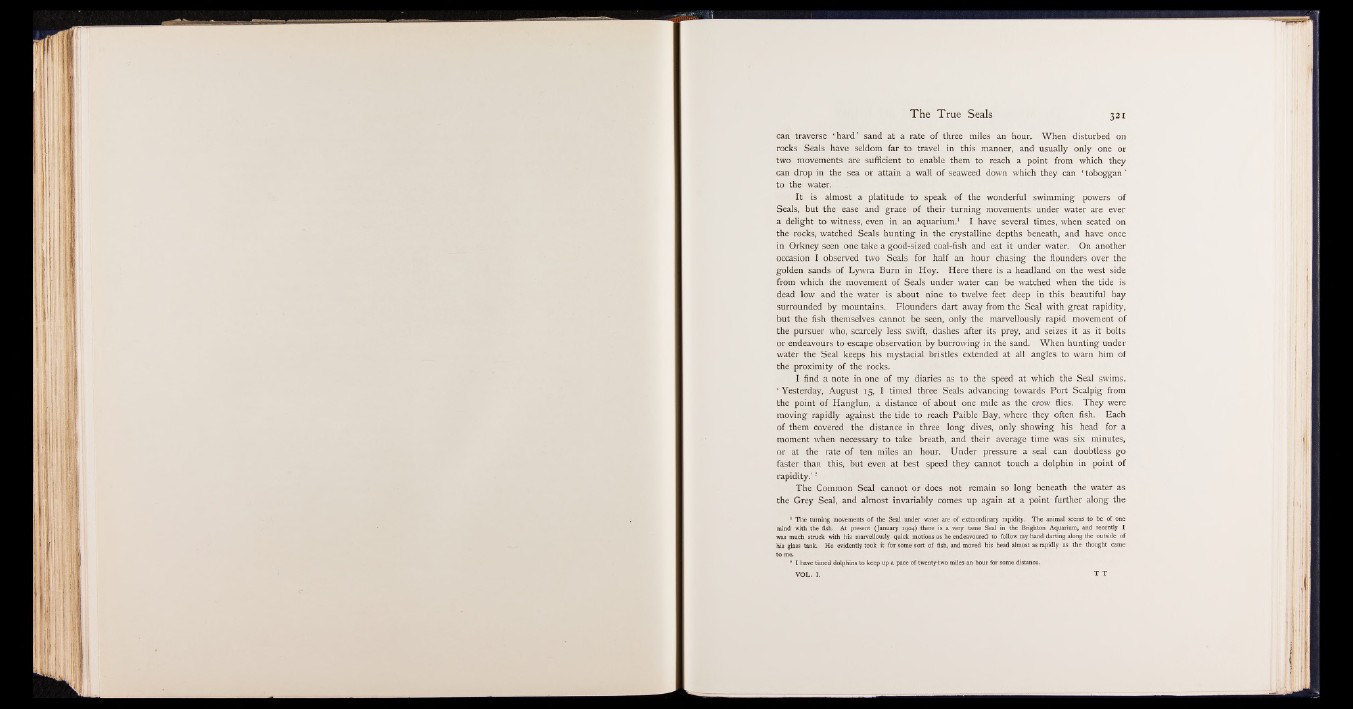
can traverse ‘ hard’ sand at a rate of three miles an hour. When disturbed on
rocks Seals have seldom far to travel in this manner, and usually only one or
two movements are sufficient to enable them to reach a point from which they
can drop in the sea or attain a wall of seaweed down which they can ‘ toboggan ’
to the water.
It is almost a platitude to speak of the wonderful swimming powers of
Seals, but the ease and grace of their turning movements under water are ever
a delight to witness, even in an aquarium.1 I have several times, when seated on
the rocks, watched Seals hunting in the crystalline depths beneath, and have once
in Orkney seen one take a good-sized coal-fish and eat it under water. On another
occasion I observed two Seals for half an hour chasing the flounders over the
golden sands of Lywra Burn in Hoy. Here there is a headland on the west side
from which the movement of Seals under water can be watched when the tide is
dead low and the water is about nine to twelve feet deep in this beautiful bay
surrounded by mountains. Flounders dart away from the Seal with great rapidity,
but the fish themselves cannot be seen, only the marvellously rapid movement of
the pursuer who, scarcely less swift, dashes after its prey, and seizes it as it bolts
or endeavours to escape observation by burrowing in the sand. When hunting under
water the Seal keeps his mystacial bristles extended at all angles to warn him of
the proximity of the rocks.
I find a note in one of my diaries as to the speed at which the Seal swims.
‘ Yesterday, August 15, I timed three Seals advancing towards Port Scalpig from
the point of Hanglun, a distance of about one mile as the crow flies. They were
moving rapidly against the tide to reach Paible Bay, where they often fish. Each
of them covered the distance in three long dives, only showing his head for a
moment when necessary to take breath, and their average time was six minutes,
or at the rate of ten miles an hour. Under pressure a seal can doubtless go
faster than this, but even at best speed they cannot touch a dolphin in point of
rapidity.’ 2
The Common Seal cannot or does not remain so long beneath the water as
the Grey Seal, and almost invariably comes up again at a point further along the
1 The turning movements of the Seal under water are of extraordinary rapidity. The animal seems to be of one
mind with the fish. At present (January 1904) there is a very tame Seal in the Brighton Aquarium, and recently I
was much struck with his marvellously quick motions as he endeavoured to follow my hand darting along the outside of
his glass tank. He evidently took it for some sort of fish, and moved his head almost as rapidly as the thought came
to me.
* I have timed dolphins to keep up a pace of twenty-two miles an hour for some distance.
VOL. I. T T